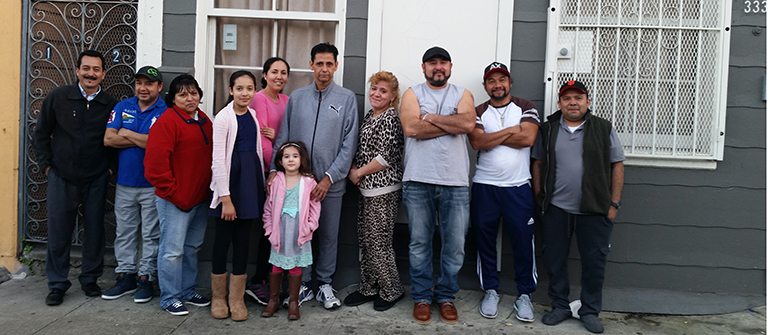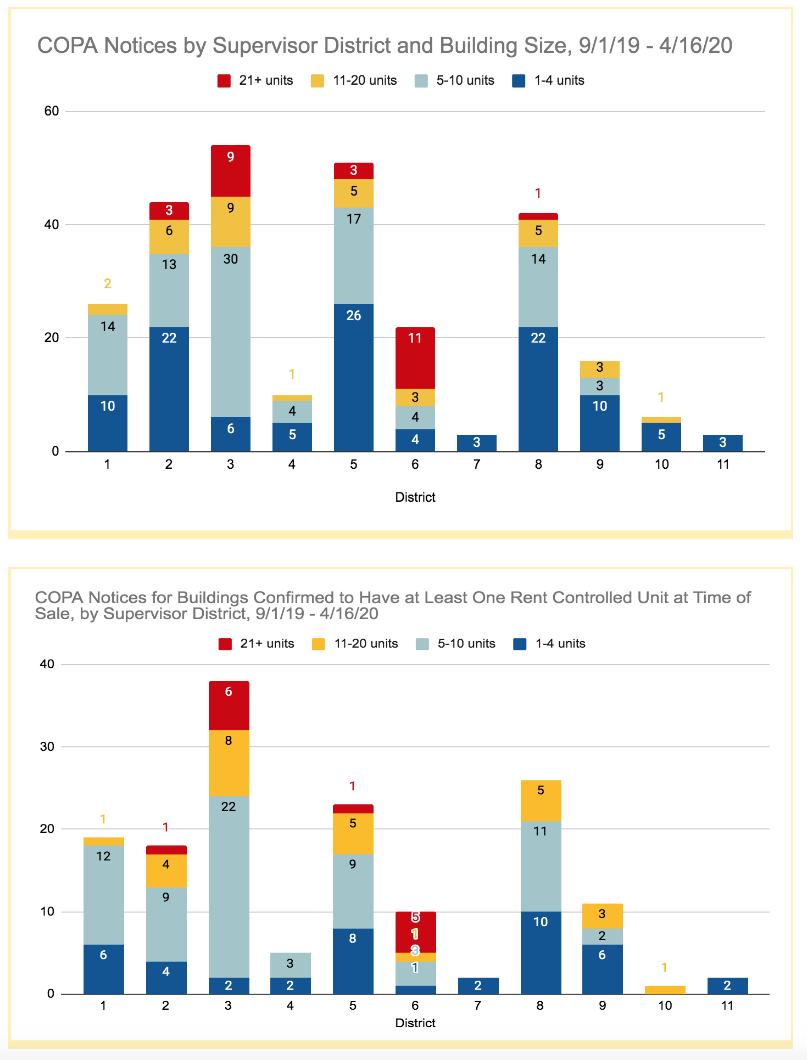 by Associate Director of Community Real Estate Johnny Oliver
by Associate Director of Community Real Estate Johnny Oliver
With it being almost one year since the implementation of San Francisco’s pioneering Community Opportunity to Purchase Act, known as COPA for short, we were asked by SPUR to reflect on the successes and challenges of this program that aims to preserve affordable housing. It is also imperative to look at COPA through the lens of the “new normal” precipitated by the current COVID-19 crisis, where we are already seeing adverse effects on housing and small business stability, especially in low-income communities of color.
The goal and the numbers
The legislation for COPA was pushed for by tenants’ rights activists and enacted by the San Francisco Board of Supervisors to ensure qualified nonprofits had the right of first offer and/or the refusal to purchase eligible properties on the market. After four years of acquiring housing off the private market though the Small Sites Program, nonprofit developers and tenant advocates were faced with two challenges: many buildings were continuing to be sold off-market; and sellers were often not willing to consider offers from community-based organizations. The idea of COPA was to ameliorate these issues as a means to stemming the displacement of low-income tenants vulnerable to eviction.
Now, when sellers are getting ready to market their buildings they are legally required to provide a five-day notice to qualified nonprofits. If the nonprofit expresses interest, they then have 25 days to provide an offer. If that offer is accepted, the building goes into contract for purchase; conversely, if the offer is not accepted, the nonprofit has the right of countering any future offers, provided they can match terms.
Starting last September 3 when the legislation was officially implemented, MEDA’s Community Real Estate team was inundated each week with real estate COPA notices. This showcased what we always thought to be the case: San Francisco has many pocket listings, which are listings that are directly sold between brokers and that never hit the public Multiple Listing Service (MLS). That’s why COPA made sense, as a way for nonprofits, such as MEDA, to be availed of offerings that never even hit the MLS. COPA gives community-based organizations the chance to put in a competitive bid on buildings of three or more units, as a way to preserve affordable housing. COPA is critical in a high-cost, low-inventory market like that of San Francisco.
We are only six months into the implementation of COPA. Data indicate that in the last quarter of 2019 and the first quarter of 2020, Districts 2, 3, 5 and 8 saw the highest number of buildings being marketed, with over 40 building sales per district. Districts 1 and 6 occupied a middle tier, with slightly over 20 building sales per district over the same period. While we do not have complete data from COPA notices regarding which buildings had at least one rent-controlled unit, the partial data indicate that the same districts listed above also had the highest numbers of buildings with low rents.
With COPA, MEDA has been able to purchase three buildings and get into contract for three more in the last six months. Realtors who previously would not have advised their sellers to take an offer from a nonprofit have expressed to us their pleasant surprise at MEDA’s ability to close, despite our having a tenant-centric approach that uses City funding.

The strategy and the investment
COPA does not work on its own: The legislation requires a two-pronged investment in the capacity-building of nonprofits and in the funding of the real estate purchases.
To scale this work, the City has committed close to $3 million over the next three years, as an initial investment in building capacity of nonprofits located in neighborhoods exhibiting the greatest threat to tenants, especially in communities of color. As part of this investment, a trio of trusted community-based organizations — MEDA, the San Francisco Housing Accelerator Fund and Chinatown Community Development Corporation — are providing models for other nonprofits, plus doing a deep dive into analysis on how to scale the model.
Additionally, MEDA is leading in sharing the model of small-sites preservation by developing a toolkit for nonprofits readying themselves to serve their communities. We started by conducting an assessment of the organizations and the creation of tenant-engagement materials to support such community members on their journey to becoming residents of permanently affordable housing. A human-centered design approach is being used for a streamlined, culturally relevant user experience for these outreach materials.
The City is also providing funding of up to $375,000 per unit to ensure that these buildings can be purchased at fair market value. The committed investment for 2019-2020 is $37 million. With this funding, MEDA was able to take advantage of COPA and purchase the first three buildings referenced above.
COVID-19 necessitates why COPA is more important than ever before
COPA is one of the key legislative components of housing preservation to stem the tide of gentrification and its subsequent displacement in our communities. The City recognized this fact, which is why San Francisco’s shelter-in-place order allowed workarounds for affordable housing to carry on, being defined as “essential business.”
During the initial month of the shelter-in-place order, MEDA paused on prospective acquisitions to immediately assess and ensure that current purchases were conducted using outlined public health measures. Before moving forward with acquisitions, we now have all tenants, inspectors, general contractors and MEDA staff signed onto the safety protocols set forth by the DPH.
With a “new normal” due to the impacts of COVID-19, MEDA is well aware that the housing crisis will most likely become an economic crisis for multifamily building ownership, based on the prospective impact of the eviction moratorium. We saw this starting in fall 2008, which was the advent of the Great Recession’s foreclosure crisis. MEDA immediately stepped in to assist scores of community members in rescuing their single-family homes through loan modifications, but 3,827 households in San Francisco still lost their homes to foreclosure between 2008 and 2012. This especially impacted communities of color. Additionally, mom-and-pop landlords seeking foreclosure prevention did not have many options aside from a short-sale, and loan modifications were not common for investment properties.
Prioritization that is needed — now
To ensure the continued strength of COPA, MEDA recommends the following be immediately implemented to combat any prospective deleterious effects of the COVID-19 crisis:
- Legislation to protect residential and commercial renters who have subsidies. Such legislation must be connected to covenants for affordability; therefore, if landlords receive rental revenue from government support of renters, MEDA strongly advocates that this revenue have clauses attached that give governments the right to purchase and use the value of the vouchers to support a portion of said purchase.
- Prioritization of preservation funding. MEDA believes that the likely economic collapse of the multifamily rental market will have significant negative effects on tenants; therefore, local, county and state funding should be shifted and balanced to support acquisitions and rehabilitations of buildings housing vulnerable low-income renters.
- Capacity-building of local nonprofits so they are ready to receive these assets. The infrastructure of nonprofits remains strong; however, becoming an affordable-housing owner can be daunting, and takes a strategic shifting of organizational priorities and finances. MEDA has seen this with our own transformation from solely being a direct-services provider to tackling affordable housing starting in summer 2014 (with 1,200+ units preserved or produced). While such large-scale organizational changes will not happen overnight for other organizations, especially as an immediate response to the current economic downturn, capacity-building is vital within three to five years (if not sooner) so that our local, place-based nonprofits are best positioned to take on these assets.
Conclusion
COPA was a much-needed response to San Francisco’s affordable-housing crisis, and we applaud the City of San Francisco and MOHCD for its implementation of that legislation a year ago. COPA will evolve — as most innovative solutions must do — with changes now moving forward faster due to the COVID-19 crisis’ impact on low-income communities of color.
If done right, these changes will ensure the continued strength of COPA as a major piece of the preservation of affordable housing in San Francisco.






Leave a reply